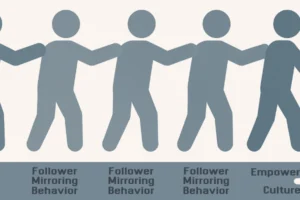Pseudo-Transformational Leaders
It is essential to understand pseudo-transformational leadership for numerous reasons, but none more important than identifying when we are being manipulated or deceived. This is, of course, a position based on opinion. Still, the fact remains that such knowledge can keep you from falling victim to a leader’s selfish ambitions and may even be able to save the organization or group long term.
Pseudo-transformational leadership is defined by self-serving yet highly inspirational leadership behaviors, an unwillingness to encourage independent thought in subordinates, and little caring for one’s subordinates in general (Christie, Barling & Turner, 2011). This is important to understand because one needs to know precisely what one is looking for when examining leadership. For instance, these leaders appear to be transformational, but generally speaking, it is later revealed that they are morally repugnant, i.e., the unethical facet of transformational leadership.
Imagine joining a group or organization where a leader took control by expressing a clear vision of direction, goals, obstacles, and solutions. This leader conveyed great passion with a strong sense of “know-how.” This leader had a way of recharging everyone and getting everyone excited and energized about the task. This is more than likely a transformational leader.
Now imagine that this same person’s real goals were shady or underhanded. Imagine that the path he or she suggests would put your group in danger. Furthermore, while you were all excited about the mission, it turns out that the mission led to the one place the group had said they didn’t want to go. You are probably amid a pseudo-transformational leader.
Pseudo-transformational leaders are probably a lot more prevalent than we would like to admit, and when they present themselves, it is usually in a huge way. For example, leaders such as Adolph Hitler, Mao Zedong, and even Osama bin Laden were all able to inspire their followers to do some amazing things. However, their actions and aspirations ultimately brought their followers a great deal of death. This occurs through a violation of trust, immoral acts, and a fundamental lack of good character or a combination of them all.
The same can be said for the corporate environment. A great example of this could be found with Wal-Mart. H. Lee Scott, Jr, former Walmart CEO, could be listed as a pseudo-transformational leader. Evidence of this comes from 2005 when Walmart suddenly (and seemingly out of nowhere) made a public commitment regarding environmental sustainability (Wal-Mart, 2014). Wal-Mart had announced a goal to create zero waste and use only renewable energy. This was great PR for the company, which benefited the company substantially in the long run. Wal-Mart looked like a corporate innovator and leader, especially since the Kyoto Protocol had just officially gone into effect.
However, Wal-Mart Stores has since paid multiple millions of dollars in penalties as part of a guilty plea on criminal charges for negligently dumping hazardous waste in California and Missouri; violations that occurred between 2003 and 2005 (Neuman, 2013). Was this sudden generosity and eco-friendliness in 2005, or an underhanded way to get some positive PR before the charges stuck?
Corporate and government organizations will have to deal with their share of pseudo-transformational leaders. Not every leader can be a Steve Jobs or Jack Welch. Let us take the discussion from Bass & Steidlmeier’s article “Ethics, character, and authentic transformational” (1999) and turn it into a question. Can you imagine a leader who seeks power or position, even at the expense of their followers’ achievements? Perhaps the position itself is more appealing than the job that needs to be done. Perhaps they profess the good of the group while destroying foundational ideals and individual identity. Maybe their arrogance keeps them from making the right decisions while insisting that their followers can trust them. Perhaps their ideas are idealistic, unachievable, or simply grandiose. Or maybe this leader continues to push rules for the group that do not apply to them, as if somehow their decisions, actions, or existence cannot be checked by such rules or laws.
The sad part is that while I write this, I can think of many corporate and government leaders who fit this list like a glove. There is no doubt that you can too. These are the characteristics of pseudo-transformational idealized leaders, who manipulate and deceive for selfish ambitions. These are the people that we must identify and guard against. These people must be replaced for the good of the group or organization. These are the ones who ruin the office’s reputation or position for those who are genuine and authentic transformational leaders.
So cognize, it is highly relevant to understand pseudo-transformational leadership from a self-preservation standpoint alone. Suppose your leader is putting you or your group in danger, disregarding your opinions or concerns, pushing aside or ignoring fundamental rules or regulations, or leading you to someplace you know you should not go or do not support. In that case, your group needs to be able to identify this and act accordingly. Pseudo-transformational leadership is very dangerous. The body count left or aftermath by previously identified pseudo-transformational leaders should be evidence enough.
If you enjoyed this article, you might also like my article covering Transformational Leadership.
References
- Bass, B. M., & Steidlmeier, P. (June 01, 1999). Ethics, character, and authentic transformational leadership behavior. The Leadership Quarterly, 10, 2, 181-217.
- Christie, A, Barling, J., & Turner, N. (December 01, 2011). Pseudo-Transformational Leadership: Model Specification and Outcomes¹. Journal of Applied Social Psychology, 41, 12, 2943-2984.
- Neuman, S. (2013, May 28). Wal-mart to pay $81 million for hazardous waste dumping. Retrieved from http://www.npr.org/blogs/thetwo-way/2013/05/28/186951760/wal-mart-to-pay-81-million-for-hazardous-waste-dumping
- Wal-Mart. (2014). History timeline. Retrieved from http://corporate.walmart.com/our-story/history/history-timeline




